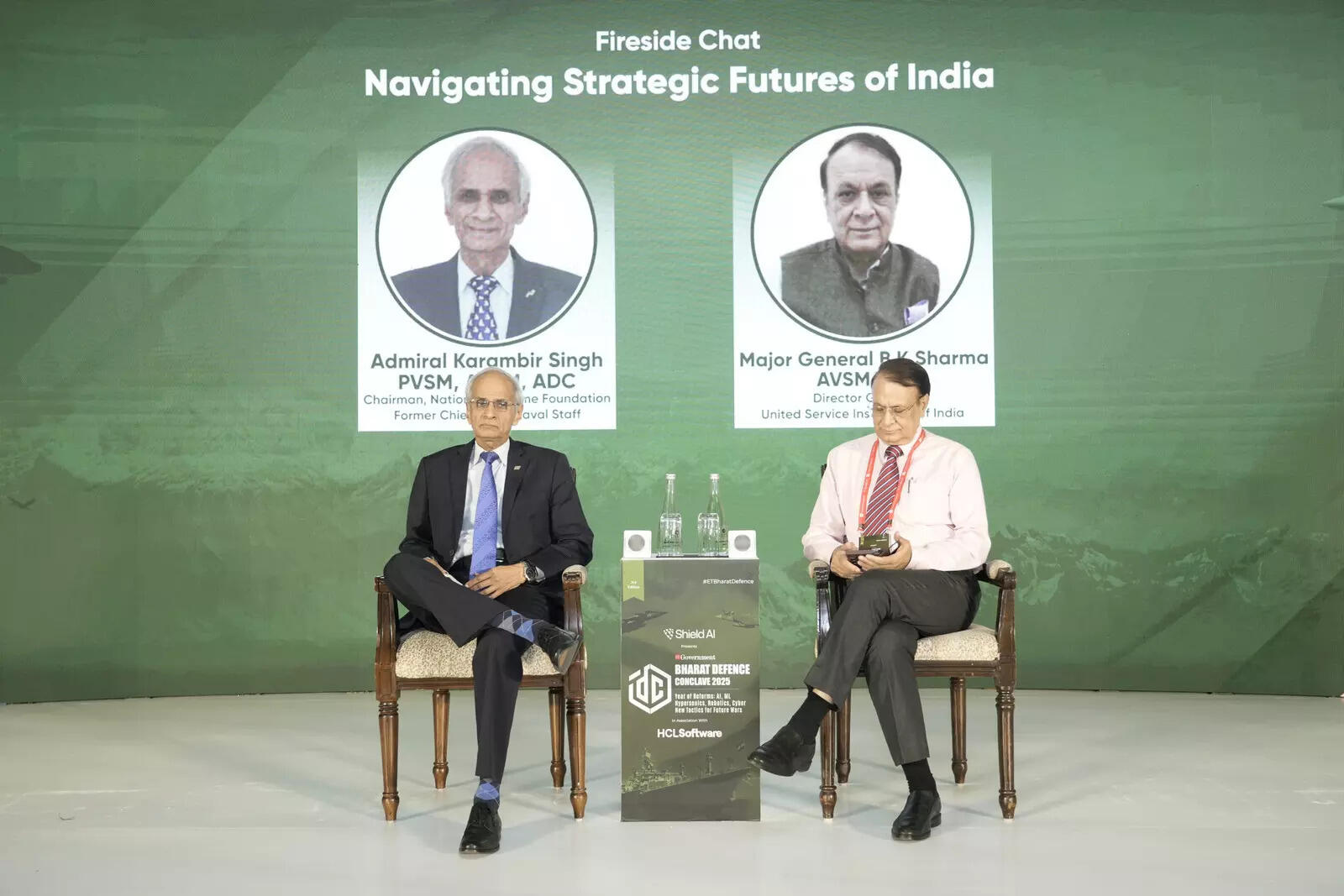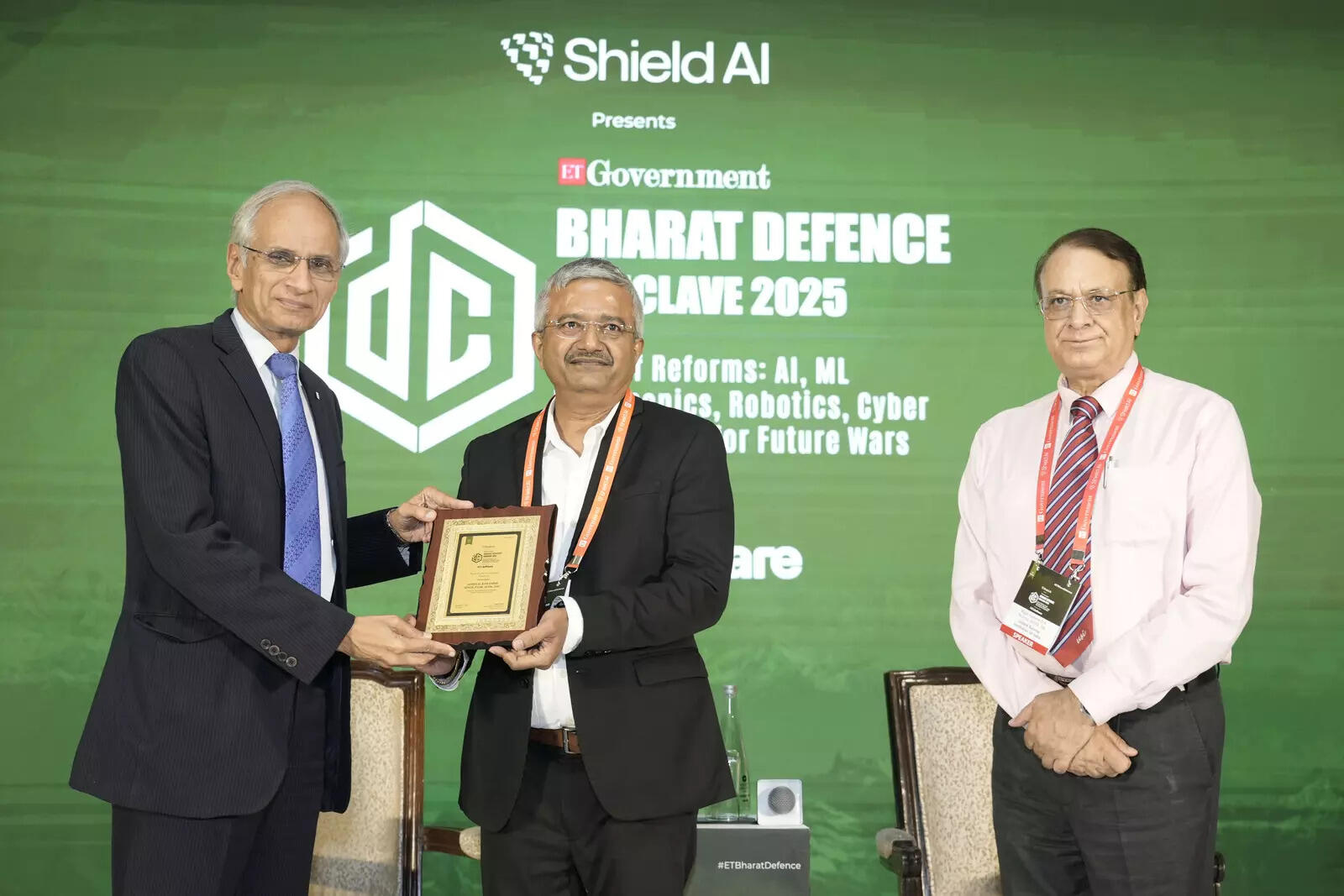
The Bharat Defence Conclave 2025, held on September 25 at the Hyatt Regency, New Delhi, convened India’s foremost defence leaders, policymakers, diplomats, and military officers for a day of deep deliberations on the country’s evolving security landscape.
Over 400 participants—including more than 150 serving officers, senior officials from the Ministry of Defence, DRDO, and representatives of over 30 foreign missions—made the conclave a premier platform for strategic thought and exchange.
One of the most compelling sessions was the fireside chat, “Navigating Strategic Futures of India,” featuring Admiral Karambir Singh, PVSM, AVSM, ADC, Chairman of the National Maritime Foundation and former Chief of the Naval Staff, in conversation with Major General B. K. Sharma, AVSM, SM, Director General of the United Service Institution of India (USI).
A Volatile Strategic Landscape
Opening the discussion, Maj. Gen. Sharma underlined the gravity of the moment. He noted that India had once found itself in a “sweet spot” of stability, but the last few years had brought unexpected turbulence.
|

“We are now face-to-face with a very uncertain and unusual environment,” he remarked, pointing to the shifting posture of the United States under Trump-era policies, the tightening embrace between China and Pakistan, and new alignments involving Turkey, Saudi Arabia, and Azerbaijan.
He described the scene starkly: “We are living in a very complex and volatile strategic environment, where multiple fault lines—on our borders, in our maritime space, and in neighbouring states—are converging.”
Admiral Karambir Singh agreed, but broadened the frame. “Indeed, we are going through very difficult, challenging times where everything seems to be getting weaponized—technology, currencies, critical commodities. International relations today span a spectrum from cooperation to confrontation, and conflict is no longer theoretical. India must be careful not to get sucked into this negative spiral of geopolitical confrontation.”
Security Beyond Borders
Admiral Singh stressed that India’s security calculus has expanded far beyond territorial boundaries. “Traditionally, armed forces looked at protecting physical borders. But today, we must protect cyber borders, digital borders, even cognitive spaces. Security has to be seen in a much broader sense if we are to achieve the vision of a developed India by 2047.”
Maj. Gen. Sharma added that India’s continental fixation must be balanced with maritime opportunities. “Our contested borders with China and Pakistan have kept us land-focused, but unless we capitalise on our maritime space, we will not be able to achieve our developmental goals,” he said.
The Maritime Imperative
Admiral Singh, drawing on his experience as a naval leader, pointed to the fragility of India’s sea lines of communication. “Nearly 95 percent of our trade by volume moves through the seas. If those maritime highways are disrupted, our prosperity is at risk. The Red Sea crisis has already shown how quickly vulnerabilities can spread—nearly 70 percent of our trade is impacted by disturbances in the Red Sea, South China Sea, and other choke points.”
He emphasised that India’s maritime diplomacy is designed not just to safeguard national interests but also to build collective resilience. “India cannot rise in isolation. Our maritime diplomacy is meant to strengthen regional stability and ensure our neighbours are not destabilized by external shocks. As our External Affairs Minister often says, India’s rise must lift all boats together.”
Singh elaborated on India’s approach: “When we talk about free, open, and secure seas, it has meaning. We are focusing on maritime diplomacy to strengthen partnerships with like-minded navies, to build collective maritime competence, and to ensure that India is a trusted security partner in the region.”
Capabilities and Reforms
While diplomacy remains vital, Admiral Singh was clear that credible capabilities are indispensable. “Shaping the environment is vital, but when push comes to shove, strength must be respected. We must build the desired capabilities to deter and respond effectively.”
He highlighted the need for enhanced maritime domain awareness, integrated response mechanisms across 23 stakeholders under the National Maritime Security Coordinator, and progress on theatre commands and tri-service integration. India’s geography, especially the Andaman and Nicobar Islands, he argued, must be leveraged as strategic assets.
Technology, in his view, demands a new approach. “We need to change the way we think about technology adaptation and procurement. There is a mismatch between the pace of technological cycles and our acquisition processes. Software-intensive systems cannot be treated as finished products—they must evolve continuously. We should study models like the U.S. Speed Act 2025, which collapses acquisition timelines to keep pace with innovation.”
Whole-of-Nation Security
As the discussion drew to a close, Admiral Singh reminded the audience that national security could no longer be the sole responsibility of the armed forces. “Today is the time for us to adopt a whole-of-nation approach to national security. It is not the purview of the armed forces alone, but of every citizen. Institutions like the NCC can play a crucial role in preparing the youth.”
Quoting memorably, he concluded: “Love thy neighbour—but never send your food. That is the mantra India must adopt.”
Maj. Gen. Sharma, reflecting on the session, emphasised that strategic foresight must remain central. “Unless India anticipates and adapts to both continental and maritime realities, our national interests will remain under pressure. What we need is resilience—military, economic, and societal.”
Conclusion
The fireside chat between Admiral Karambir Singh and Maj. Gen. B. K. Sharma revealed both the depth of India’s external challenges and the opportunities in its maritime horizon.
Singh’s call for broad-based security, stronger maritime capabilities, and adaptive technology acquisition underlined the direction in which India must move. Sharma’s reminder of India’s contested borders and volatile neighbourhood grounded the discussion in immediate realities.
Together, their insights reaffirmed that India’s path to becoming a developed nation by 2047 rests on balancing continental caution with maritime ambition, diplomacy with deterrence, and military strength with a whole-of-nation commitment to security.
(The author is Editor-News, ETGovernment)

